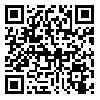BibTeX | RIS | EndNote | Medlars | ProCite | Reference Manager | RefWorks
Send citation to:
URL: http://sjsph.tums.ac.ir/article-1-25-en.html

 , Fatemeh Sedaghat
, Fatemeh Sedaghat 
 , Bahram Rashidkhani
, Bahram Rashidkhani 
 , Soheyla Mirzaeian
, Soheyla Mirzaeian 
 , Majid Moasheri
, Majid Moasheri 
 , Anahita Hoshyarrad
, Anahita Hoshyarrad 
 , Mostafa Mirghotbi *
, Mostafa Mirghotbi * 
 1
1
Background and Aim: To examine the association of diet and the risk of esophageal squamous cell carcinoma (SCC) in Kurdistan province.
Materials and Methods: This was a case-control study including 47 patients with esophageal SCC and 96 healthy controls. Dietary intake was assessed using a valid semi-quantitative food frequency questionnaire. Logistic regression analysis was run to estimate odds ratios and 95% confidence intervals.
Results: The controls had a significantly higher mean body mass index (25.3 vs. 20.4) and a higher level of education than the case group, while the latter had significantly higher records of tobacco consumption and symptomatic gastresophageal reflux. An independent protective effect was observed for the highest tertile of total fruit consumption (OR: 0.13, CI: 0.04-0.45, p-value=0.001). Within the fruits group, a significant inverse association was observed for bananas, kiwis and oranges (P for trends: 0.03, 0.02 and 0.01, respectively). The effect of total vegetable intake on esophageal SCC was not significant (OR: 0.66, CI: 0.23-1.87), although a reduction in risk was observed in the highest tertile of intake. With regard to other food groups we did not find a statistically significant association.
Conclusion: The results of the present study suggest an inverse association only between fruit consumption and esophageal SCC.
Received: 2011/09/3 | Accepted: 2012/01/17 | Published: 2013/09/11
| Rights and permissions | |
 |
This work is licensed under a Creative Commons Attribution-NonCommercial 4.0 International License. |



